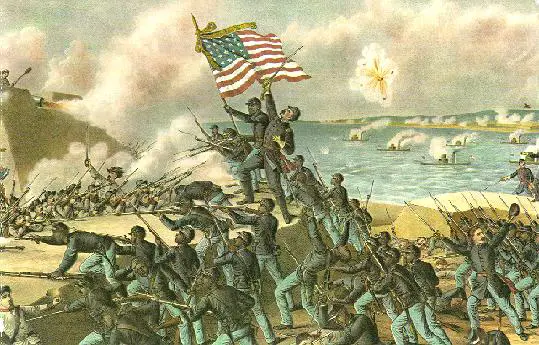The 54th Massachusetts: History on the Battlefield
The North was undoubtedly more sympathetic than the South, but regiments of the Union were overwhelmingly not Black, and this was the case for a good part of the war. This changed significantly with, among other things, the announcement of the Emancipation Proclamation and the organization of an "experimental" all-Black regiment, the 54th Massachusetts. This regiment was formed in March 1863, nearly two full years into the war, and organized by Robert Gould Shaw, a young (white) abolitionist. Among the recruits, who were mostly from Massachusetts and Pennsylvania, were Charles Douglass and Lewis N. Douglass, sons of the former slave and famous abolitionist Frederick Douglass. After a few months of training exercises, the 54th Massachusetts got their orders: They were to report to Hilton Head, South Carolina, where they arrived in early June. A month later, they saw their first combat action in a skirmish on nearby James Island. They saw the most severe action—and earned most of their fame—from the part they played in an attack on Fort Wagner, on Morris Island, on July 18, 1863. The fort was heavily defended, with both cannons and sharpshooters. Nonetheless, the order came for the 54th Massachusetts to lead the way in storming the fort. They did just that, advancing through a withering storm of enemy fire. Many soldiers made it over the wall and into the fort. The vast majority, however, died in the attempt. That day, 281 men died, among them Colonel Shaw, who died urging his men to continue the advance.
One member of the 54th Massachusetts who survived that day was Sergeant William Carney. He refused to let the flag of his regiment fall to the ground or be captured by the enemy. He was shot multiple times but survived and was later awarded the Congressional Medal of Honor. (Read his story here.) The heroism of the Black men who fought that day was relayed throughout the North (and South). Recruiting of Blacks in the North increased markedly. The 54th Massachusetts was reinforced, and they fought several more times during the war, mostly in the South. One of their main successes was as part of the siege of Charleston. With the end of the Civil War, the 54th Massachusetts was disbanded, in August 1865. Their heroism and professionalism lives on, particularly in the relatively recent Hollywood movie Glory. |
|
Social Studies for Kids
copyright 2002–2025
David White



